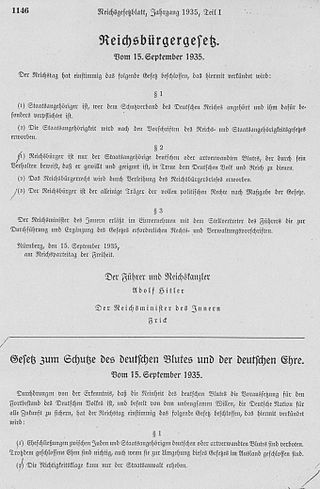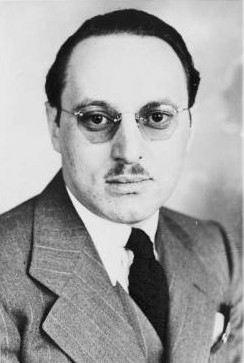
Julius Streicher was a member of the Nazi Party, the Gauleiter of Franconia and a member of the Reichstag, the national legislature. He was the founder and publisher of the virulently antisemitic newspaper Der Stürmer, which became a central element of the Nazi propaganda machine. The publishing firm was financially very successful and made Streicher a multi-millionaire.

Der Stürmer was a weekly German tabloid-format newspaper published from 1923 to the end of World War II by Julius Streicher, the Gauleiter of Franconia, with brief suspensions in publication due to legal difficulties. It was a significant part of Nazi propaganda, and was virulently anti-Semitic. The paper was not an official publication of the Nazi Party, but was published privately by Streicher. For this reason, the paper did not display the Nazi Party swastika in its logo.

The Völkischer Beobachter was the newspaper of the Nazi Party (NSDAP) from 25 December 1920. It first appeared weekly, then daily from 8 February 1923. For twenty-four years it formed part of the official public face of the Nazi Party until its last edition at the end of April 1945. The paper was banned and ceased publication between November 1923, after Adolf Hitler's arrest for leading the unsuccessful Beer Hall Putsch in Munich, and February 1925, the approximate date of the relaunching of the Party.

Rassenschande or Blutschande was an anti-miscegenation concept in Nazi German racial policy, pertaining to sexual relations between Aryans and non-Aryans. It was put into practice by policies like the Aryan certificate requirement, and later by anti-miscegenation laws such as the Nuremberg Laws, adopted unanimously by the Reichstag on 15 September 1935. Initially, these laws referred predominantly to relations between ethnic Germans and non-Aryans, regardless of citizenship. In the early stages the culprits were targeted informally; later, they were punished systematically and legally.

The propaganda used by the German Nazi Party in the years leading up to and during Adolf Hitler's dictatorship of Germany from 1933 to 1945 was a crucial instrument for acquiring and maintaining power, and for the implementation of Nazi policies.
Philipp Rupprecht was a German cartoonist best known for his anti-Semitic caricatures in the Nazi publication Der Stürmer, under the pen-name Fips.

Untermensch is a German language word literally meaning 'underman', 'sub-man', or 'subhuman', that was extensively used by Germany's Nazi Party to refer to non-Aryan people they deemed as inferior. It was mainly used against "the masses from the East", that is Jews, Roma, and Slavs.

Das Reich was a weekly newspaper founded by Joseph Goebbels, the propaganda minister of Nazi Germany, in May 1940. It was published by Deutscher Verlag.

Der Giftpilz is a piece of antisemitic Nazi propaganda published as a children's book by Julius Streicher in 1938. The text is by Ernst Hiemer, with illustrations by Philipp Rupprecht ; the title alludes to how, just as it is difficult to tell a poisonous mushroom from an edible mushroom, it is difficult to tell a Jew apart from a Gentile. The book purports to warn German children about the dangers allegedly posed by Jews to them personally, and to German society in general.
Jewish Bolshevism, also Judeo–Bolshevism, is an antisemitic conspiracy theory that claims that the Russian Revolution of 1917 was a Jewish plot and that Jews controlled the Soviet Union and international communist movements, often in furtherance of a plan to destroy Western civilization. It was one of the main Nazi beliefs that served as an ideological justification for the German invasion of the Soviet Union and the Holocaust.

The Holocaust in Ukraine was the systematic mass murder of Jews in the Reichskommissariat Ukraine, the General Government, the Crimean General Government and some areas which were located to the East of Reichskommissariat Ukraine, in the Transnistria Governorate and Bessarabia, Northern Bukovina and the Hertsa region and Carpathian Ruthenia during World War II. The listed areas are currently parts of Ukraine.
Eliminationism is the belief that a social group is, in the words of Oklahoma City University School of Law professor Phyllis E. Bernard, "a cancer on the body politic that must be excised—either by separation from the public at large, through censorship or by outright extermination—in order to protect the purity of the nation."

Theodore Newman Kaufman, sometimes given incorrectly as Theodore Nathan Kaufmann, was an American Jewish businessman and writer.

The propaganda of the Nazi regime that governed Germany from 1933 to 1945 promoted Nazi ideology by demonizing the enemies of the Nazi Party, notably Jews and communists, but also capitalists and intellectuals. It promoted the values asserted by the Nazis, including Heldentod, Führerprinzip, Volksgemeinschaft, Blut und Boden and pride in the Germanic Herrenvolk. Propaganda was also used to maintain the cult of personality around Nazi leader Adolf Hitler, and to promote campaigns for eugenics and the annexation of German-speaking areas. After the outbreak of World War II, Nazi propaganda vilified Germany's enemies, notably the United Kingdom, the Soviet Union and the United States, and in 1943 exhorted the population to total war.

Nazi propaganda towards the United Kingdom changed its position over time in keeping with Anglo-German relations. Prior to 1938, as the Nazi regime attempted to court the British into an alliance, Nazi propaganda praised the "Aryan" character of the British people and the British Empire. However, as Anglo-German relations deteriorated, and the Second World War broke out, Nazi propaganda vilified the British as oppressive German-hating plutocrats. During the war, it accused "perfidious Albion" of war crimes and sought to drive a wedge between Britain and France.

The Nazi Party and its ideological allies used cartoons and caricatures as a main pillar in their propaganda campaigns. Such techniques were an effective way to spread their ideology throughout Nazi Germany and beyond. The use of caricatures was a popular method within the party when pursuing their campaign against the United States, in particular its then-President Franklin D. Roosevelt.

During a speech at the Reichstag on 30 January 1939, German Führer Adolf Hitler threatened "the annihilation of the Jewish race in Europe" in the event of war:
If international finance Jewry inside and outside Europe should succeed in plunging the nations once more into a world war, the result will be not the Bolshevization of the earth and thereby the victory of Jewry, but the annihilation of the Jewish race in Europe.
Wolfgang Diewerge was a Nazi propagandist in Joseph Goebbels' Reich Ministry of Popular Enlightenment and Propaganda. His special field was anti-Semitic public relations, especially in connection with trials abroad, which could be exploited for propaganda purposes. He also played an essential role in the preparation of a show trial against Herschel Grynszpan, whose assassination attempt on a German embassy employee in Paris had been used by the Nazis as a trigger for the November pogroms in 1938. In 1941, his pamphlets on the so-called Kaufman Plan and the Soviet Union were published in print runs of millions. After the war, Diewerge managed to re-enter politics via the FDP North Rhine-Westphalia. However, the intervention of the British occupation authorities and a commission of the FDP's Federal Executive Committee put an abrupt end to this intermezzo. In 1966 Diewerge was convicted of perjury for his statements made under oath about the Grynszpan trial planned by the National Socialists. After all, he was involved in the Flick donations affair as managing director of two associations.

Parole der Woche was a wall newspaper published by the Reichspropagandaleitung der NSDAP from 1937 to 1943. Historian Jeffrey Herf describes Parole der Woche as "the most ubiquitous and intrusive aspect of Nazism's visual offensive ... no form of Nazi visual propaganda made so crucial a contribution to the regime's presentation of ongoing events".
The claim that there was a Jewish war against Nazi Germany is an antisemitic conspiracy theory promoted in Nazi propaganda which asserts that the Jews, framed within the theory as a single historical actor, started World War II and sought the destruction of Germany. Alleging that war was declared in 1939 by Chaim Weizmann, president of the World Zionist Organization, Nazis used this false notion to justify the persecution of Jews under German control on the grounds that the Holocaust was justified self-defense. Since the end of World War II, the conspiracy theory has been popular among neo-Nazis and Holocaust deniers.
















